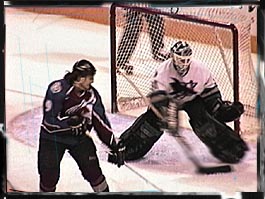

|
Sharks Goalie Wade Flaherty keeps his eye on the puck and on the opposing
player in front of him.
|
|
Hockey goalies have one of the most challenging
occupations on the planet. Imagine trying to stop a six-ounce piece
of frozen rubber traveling at speeds in excess of 100 mph (160 km
per hour). Or wearing 50 pounds (22 kg) of equipment and losing
5 to 7 pounds (2-3 kg) of your own body weight in just a few hours
during a game. Goalies do all of these things and more. Reaction
time, mental preparation, and other facets of life in the net are
examined by players and scientists in this section.
In this section, there are RealAudio and video
clips from Sharks goalie Kelly Hrudey.
|
|
Fractions of a second
Goalies have many unique qualities, one of which is excellent
reaction time. In a game where the puck travels at high speeds, the difference
between a goal and save can come down to milleseconds. How do you develop
reaction time? Is it something you're born with? "I really don't think
that you take anybody off the street without some prior God-given ability,"
Sharks Goalie Kelly Hrudey told us. The Exploratorium's Director of Life
Sciences, Charles Carlson seems to agree, stating that reaction time is
a "genetic trait." However he believes that you can improve your
ability to react through practice since it is also a "memory function."
Reaction time depends on both genetics and training.
|

|
San Jose Sharks Goalie Kelly Hrudey talks about reaction
time.
|
|
Saves
Goalies make several different types of saves depending
on the situation. Stick-saves, glove-saves, blocker saves, and kick-saves
are all part of the hockey vocabulary. Which type of save does a goalie
employ? The answer seems to be that when he only has a fraction of a second
to stop the puck, he uses whatever part of his body or equipment is closest.
If you watch a goalie's save closely. you'll see that if he's in position
he'll need to move only a very small distance to stop the puck.
|
|
Reaction time
In a high-speed sport such as hockey, players' reflexes
are of supreme importance. A player's reaction time can often determine
the outcome of a game. A notable example of this is the reaction time of
a professional hockey goalie. Many a fan of the game has watched in bewilderment
as a goal keeper's limbs are flailing about saving pucks left and right.
It's amazing that most most of the games remain relatively low scoring after
watching powerful players rip 90-mile-per-hour (144 km per hour) slapshots
at the goal.
|
|
Click the "forward"
button below to continue.
|

©
Exploratorium
|